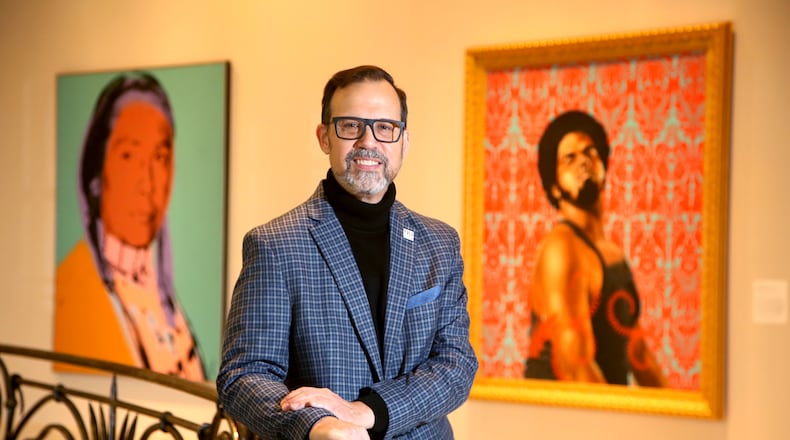When he was hired as executive director in 2011, he heard from various segments of the Dayton community who felt the museum wasn’t for them. Thinking long-range, he changed the narrative, implementing measures curatorially and through board positions he feels has been beneficial for all.
“The Black community, Jewish community and LGBTQ+ community said they didn’t feel welcomed,” Roediger said. “If people who live around the neighborhood, which is predominately Black now, don’t feel welcomed — they’re just walking by this big palace — we’re doing something wrong. So, we started what (became) our IDEA (Inclusion, Diversity, Equity and Accessibility) work, which has been woven into everything we do. As I told Dr. Jerry Smith, our head curator, we have to represent everybody.”
Credit: Hannah Kasper
Credit: Hannah Kasper
The DAI is showcasing “The Triumph of Nature: Art Nouveau from the Chrysler Museum of Art” through Jan. 11, 2026, but Roediger acknowledges the artistic balance of having recently presented “Curtis Barnes, Sr., Dayton Icon,” which brought renewed awareness to one of Dayton’s finest visual artists.
“Curtis Barnes was an incredible, contemporary, abstract Black artist that was known in the Black community but not in the greater community,” Roediger said. “We’re missing telling these stories and communities seeing themselves on the walls and in our collection. We will either have a main or focused exhibition every year that represents the (Black) community. We have a Holocaust remembrance show for kids (”The Max May Memorial Holocaust Art" exhibition), and we’re trying to do more with the LGBTQ+ community. It’s about wanting people at the table. We want people to have a voice here. One of the things I hope is my legacy that stays forever is that we remain inclusive and people know this is a place for them. Everybody appreciating everyone’s art is important.”
He’s also proud of an upcoming land acknowledgment that will stand as a permanent historical marker on the museum grounds.
“It’s a promise I made to the Indigenous people of Dayton and it’s a promise I want to keep,” Roediger said. “Promises and trust are important. I learned this from my parents while growing up in Trotwood.”
Assessing the future
During his time at the DAI, Roediger led the organization in the retiring of $16 million in debt and raised an additional $19 million in capital and endowment funding. He has also overseen the renovation of the museum’s historic grand staircases, fountains, galleries, the Rose Auditorium and the education floor, as well as making the museum more accessible for guests with different abilities and ensuring numerous works were conserved for the preservation of the collection.
In addition to hoping his successor maintains an attention to community, a long-term care for the collection and ensures the staff is taken care of, he hopes long-term financial stability will be a top priority.
“It’s $40,000 a day to run this building,” Roediger said. “It’s a tough, expensive proposition for everyone. We should never move out of this building — it’s a beacon for Dayton — but I hope we can get the kind of community support we need. I hope people take memberships or makes the DAI part of their annual giving. And we’ve worked toward that but everything has gotten more expensive. We’re constantly working on the roof and HVAC system. There is also so much care of the art that has to be done such as climate control and security.”
He also hopes his successor values representation in the collection, particularly housing more contemporary works.
“I can’t undo 100 years of collecting nor would I want to but other people exist in the world,” Roediger said. “I would like to see our Hispanic and African American collections grow. We have very few Hispanic works. But I hope the values we’ve brought and built continue.”
Looking ahead, Roediger avoids the word retirement, acknowledging his father, the late architect Richard M. Roediger, worked until age 83. As he anticipates his next role, he plans to travel (Italy, Iceland, New Zealand and Bora Bora are on his bucket list) and, most importantly, continue to call Dayton home.
“I’m very excited about my future,” he said. “I’m really proud of what we accomplished in the years I’ve been here. I’ve had a great time and great colleagues. I will be cheering them on from the sidelines.”
Roediger’s final day is Oct. 31. To honor the DAI, per his request, there will be no farewell celebration. Rather, he requests gifts be made to the museum in his honor. For more information about donating, contact Membership and Individual Giving Officer Kaytee Yantis-Houser by email at khouser@daytonart.org or by phone at 937-223-5277, ext. 264.
Top 5 memories
Here are Roediger’s top five memories from his time leading the DAI.
1. “Having the opportunity to work with so many amazing people over the years has been an amazing experience. I have learned so much from all of them and their expertise. Many will remain close friends and my extended family.”
2. “We established a ‘Pay Off the Debt Fund’ and saved the funds to do so. When the investment Committee and the Board agreed to pay off the $16 million in bond debt it was a great day of celebration. We had an official bond burning and that will always remain one of my fondest memories!”
3. “It was a true turning point when I requested the Board vote to create an IDEA (Inclusion, Diversity, Equity and Accessibility) Board Standing Committee. We committed ourselves to making everyone feel welcome, included, and having a seat at the table!”
4. “Negotiating the purchase of “The Honorable Augustus Keppel, Admiral of the Blue II” by Kehinde Wiley was one of the highlights of my time at the museum. I could not imagine it leaving us after being on a long-term loan so long. It now has its forever home at the DAI! This will always be a highlight of my time at the museum."
5. “Most memorable but not in a good way was the pandemic. No one teaches you Pandemic 101 in college. We worked together as a team on how we were going to bring the museum to people remotely and how we would communicate. The DAI staff were creative, inventive and full of grit! I am so proud of how we navigated the storm.”
About the Author





